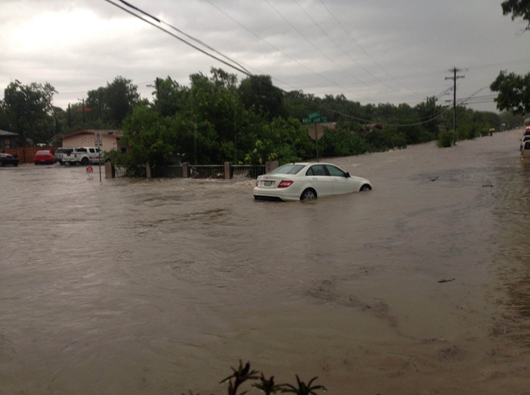RESILIENCE TO NATURAL EMERGENCIES

Local Natural Disasters
Central Texas has always been vulnerable to certain natural disasters. However, climate change has the potential to increase the frequency and impacts of threats from extreme weather. The city of Austin has identified the following as the top natural disasters Austinites face:
- Flooding–Austin is prone to flash flooding during heavy rains, especially along its urban streams, including
near Waller Creek in the North Loop neighborhood.
- Wildfire–The combination of Austin’s abundant natural vegetation, high temperatures, and frequent drought
exposes Austin to risks of wildfires.
- Severe Weather–Austin is experiencing an increase in extreme weather patterns, from the persistent lows of
2021’s Winter Storm Uri to increased summer highs exceeding 100 degrees. On March 21, 2022, six tornadoes
occurred in Central Texas.
- Pandemics–Enough said.
How the City of Austin Prepares for and Responds to Disasters
The City of Austin coordinates with multiple organizations, government and private, in planning for and responding to natural disasters. An organization responsible for coordinating emergency responses in Austin is the city’s Office of Homeland and Security Management. Not surprisingly, the city relies heavily on its routine operational functions, such as Austin Energy, Watershed Protection, and the Fire Department to respond to natural threats. Due to the importance of climate change in increasing risks for the city, the Office of Sustainability plays an increasing role in preparing for weather-related challenges.
Household Disaster Preparedness
Make a Plan
Planning involves developing an understanding of the significant risks that natural disasters could pose to your housing, your household members, and your pets. Is your housing in or near the floodplain or poorly-insulated, for example? Do you have children or household members with special medical needs or limitations? In what circumstances should you shelter-in-place and in what type of events should you plan to evacuate? What can you do to make your home more resilient to natural disaster threats? (The table below contains links to additional information on resources on emergency preparedness.)
Build a Kit
Once you have completed some planning, you should consider building two “kits.” The first kit is to ensure that your household has enough supplies on hand to shelter in place for several days. The second “kit” is to ensure your household has items it would need if you had to evacuate to another location for safety.
Know your Neighbors
Natural disasters can potentially affect the entire region, impacting the ability of the City of Austin to respond timely to some requests for assistance. Knowing your neighbors and identifying those who might need extra help during a disaster is critical to increasing Austin’s disaster preparedness. If you can help one of your neighbors, that could be one less emergency call that needs to be made.
Stay Informed
Download the Ready Central Texas app on your mobile phone and/or sign up for emergency notifications to your telephone, email, or text messages.
Local Emergency Preparedness Resources
| Category | Discussion | Resources |
|---|---|---|
| Planning | Get Prepared–A comprehensive resource for emergency preparedness in Austin. | Emergency Preparedness Guide |
| Emergency Kit and Evacuation Bag Guidance–Consider your individual risks when tailoring this “ultimate” checklist to your own needs. | Ultimate Emergency Kit Checklist | |
| Resilience Hubs–The City of Austin is working with Travis County and the Austin Independent School District to develop local resilience hubs where vulnerable residents can gather and receive assistance, if necessary, during disasters. | We will update as more information becomes available. | |
| Climate Preparedness–The City of Austin provides guidance on climate preparedness. | Austin Climate Preparedness | |
| Stay Informed | Ready Central Texas–The City of Austin and Travis County developed this free mobile app to provide resources and information in preparation for natural disasters and other emergencies. | Apple Store Link Google Store Link |
| Emergency Notifications–Ahe Capital Area Council of Governments provides registered recipients to receive emergency notifications by phone, email, or text. | Register for Emergency Warnings | |
| Flooding | Know your flood risk–The City of Austin has identified structures in the North Loop neighborhood that are closest to Waller Creek as having higher risks of flooding during extreme rain events. | Austin Flood Risk Information |
| Road Closures Due to Flooding | Road Closures Due to Flooding | |
| Fire | Wildfire–Wildfires are an increasing risk in the state, in part due to our warmer climate and worsening droughts. | Texas Wildfire Incidents Tracker |
| Fire Regulations–The City of Austin prohibits unpermitted open burning and significantly limits the use of recreational fires near structures and combustible material. | Austin Fire Regulations | |
| Severe Weather | Medically Vulnerable Individuals–Severe weather can result in the interruption of utilities. However, the City of Austin can provide additional support services to registered individuals with qualifying, vulnerable medical conditions. | Services of Medically Vulnerable or call Customer Care at 512-494-9400 |
| Austin Energy–Austin Energy’s web site allows residences to view and report power outages, as well as to sign up for outage alerts by text. | Austin Energy Outage Information Having trouble? Call 512-322-9100 | |
| Pandemics | Austin Public Health provides information and services related to various medical conditions, including COVID-19 and influenza. | Austin Public Health |